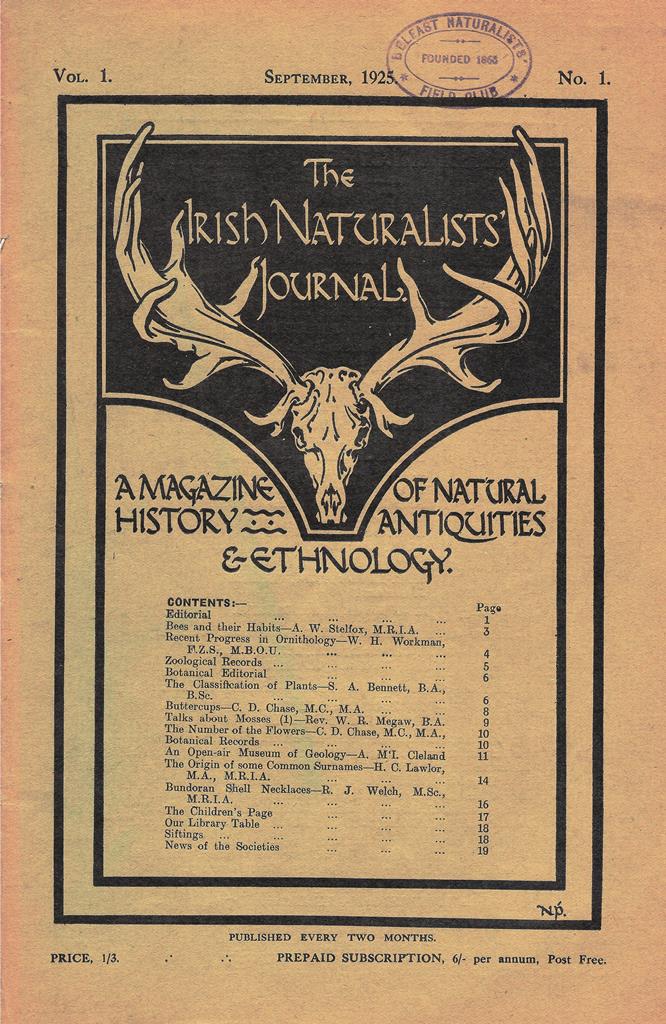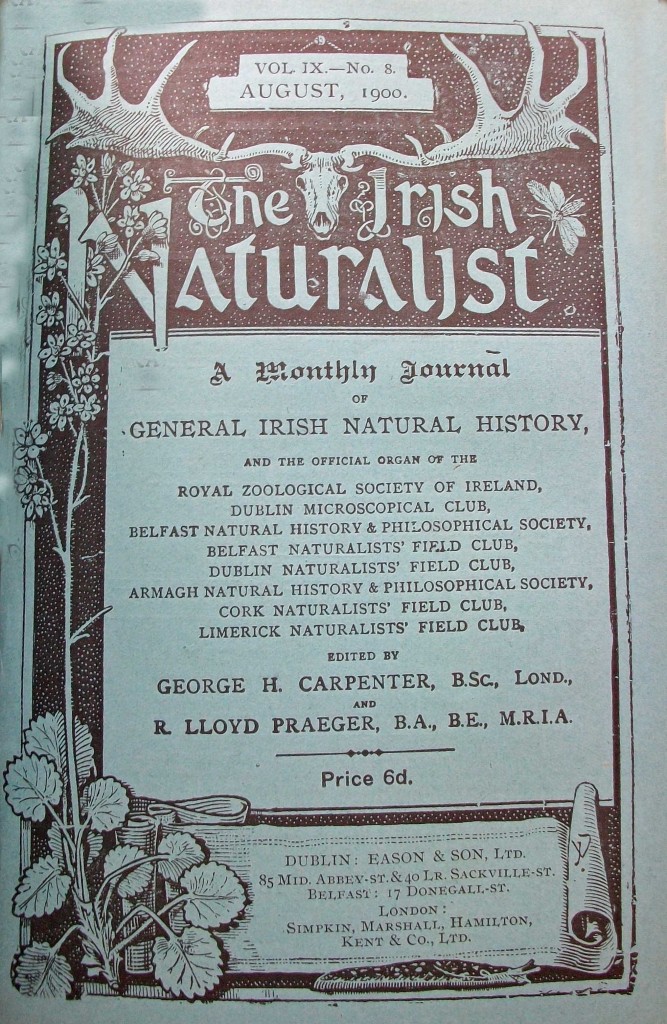Mission and Role
The Irish Naturalists’ Journal Ltd is a not-for-profit company limited by guarantee (established in 1992), registered in Northern Ireland (Company Number NI 27133). We aim to produce a journal (The Irish Naturalists’ Journal, ISSN 0021-1311) and occasional publications on Irish natural history. This has been done on an annual basis since 1925. Our products are peer reviewed quality contributions to the understanding of Ireland’s natural history in all of its aspects. Our official Memorandum and Articles of Association are available here. Our registered office is c/o National Museums Northern Ireland, Cultra, Holywood, Co. Down BT18 0EU.
Board
Dr Roy Anderson, Dr Christina Campbell, Ms Pauline Campbell (Treasurer), Dr Helen James (Secretary), Dr Maria Long, Ms Emer Magee, Mr Nigel Monaghan (Editor), Dr David Nash, Ms Margaret Norton, Dr Aidan O’Hanlon (Chair), Mr Declan Quigley, Dr Darren Reidy, Mr Lorcan Scott, Ms Eleanor Turner and Mr Dave Wall.
Editorial Committee
Editor:
Mr Nigel Monaghan, c/o National Museum of Ireland, Merrion Street, Dublin D02 F627
For all submissions to INJ, please contact the Editor at [email protected]
Sectional Editors
Botany: Dr Colin Kelleher, National Botanic Gardens, Dublin
Invertebrate Zoology: Dr Tom Bolger, University College Dublin
Vertebrate Zoology: Dr Colin Lawton, Department of Zoology, University of Galway; Dr Denise O’Meara, South East Technological University, Waterford; Mr Dave Wall, National Biodiversity Data Centre
Entomology: Dr Brian Nelson, National Parks and Wildlife Service, Dublin; Dr Aidan O’Hanlon, National Museum of Ireland
Geology and Palaeontology: Mr Nigel Monaghan, c/o National Museum of Ireland
Book Reviews: Dr Hugh Feeley
History of the INJ
The Irish Naturalists’ Journal was established in 1925 as a successor to The Irish Naturalist. Throughout its history the Journal has been open to amateur enthusiasts and professionally trained scientists. It has been run on a voluntary basis by a Board drawn from various sectors of the Irish natural history community.
The Irish Naturalist
The Irish Naturalist was an important scientific journal that was first published in April 1892. It owes its establishment to the efforts of several leading Dublin naturalists, notably G.H. Carpenter and R.M. Barrington. It was to be a medium through which naturalists could publish articles and notes about Irish natural history. It drew the majority of its authorship from the large band of naturalists that worked in Ireland at the close of the 19th century, both as amateur enthusiasts and professional scientists. It remains today as one of the most important sources for Irish natural history, and has considerably influenced present day studies in Ireland.
From the early 1800s, Ireland had become an important centre of scientific research. Various scientific institutions and societies, centred in Dublin, such as Trinity College Dublin, the Royal Irish Academy, the Royal Dublin Society and the Royal Geological Society of Ireland were forums for debate and exchange of ideas. Concurrent with the rise of science in the professional institutions, there was an increase in the fortunes of natural history. The rise coincided with the increase in leisure time largely for the middle and upper classes in Victorian Society. This led to the establishment of Field Clubs (Belfast (1863); Dublin (1886); Cork (1892); Limerick (1892)) and locally based societies and institutions. The Clubs were an important mechanism for the informal but effective education of naturalists, which was largely achieved through first-hand field studies.
The Irish Naturalist was published for 33 years and contained in total over 3000 pages, which reflect the diversity of Ireland’s flora, fauna and geology as well as its varied habitats. The journal was issued monthly and contained articles of two types. The first were major articles of 3-6 pages in length, whilst the second type were short notes of a more quirky, often humorous nature. Major articles covered the complete spectrum of natural history in Ireland: geology, geomorphology, botany, zoology, ornithology, speleology and ethnography. The many short notes were often unusual, anecdotal, and probably would not see print if submitted to modern journals. Such notes, however, add much to the The Irish Naturalist and help to give it its unique character. Papers published in the The Irish Naturalist brought recognition to a number of amateur naturalists, many of whom were later elected members of the Royal Irish Academy.
 The cover of the The Irish Naturalist was very distinctive, and featured a number of well-known ‘Irish’ species: the giant Irish deer, the Kerry spotted slug, a saxifrage, and the Galway burnet moth. It first appeared in January 1894, and replaced a rather dull predecessor used for the first few years of the Journal.
The cover of the The Irish Naturalist was very distinctive, and featured a number of well-known ‘Irish’ species: the giant Irish deer, the Kerry spotted slug, a saxifrage, and the Galway burnet moth. It first appeared in January 1894, and replaced a rather dull predecessor used for the first few years of the Journal.
Between 1900 and 1922, activities in Irish natural history began to decline for a number of reasons, including the political uncertainties. In December 1924, The Irish Naturalist ceased publication. For a number of years preceding this date, the publishers and editors attempted to keep the journal financially solvent. Barrington had subsidised the journal for some time, but he died in 1915. The following year, one issue was delayed when the printers’ premises were destroyed during hostilities on Easter Monday. Annual subscriptions were raised in 1920, but the final blow was when Carpenter, an editor since the inception of the journal, left Dublin in 1922 to take up a position in Manchester.
A shortage of publishable material was not at the root of the Journal’s trouble; rather more the frequency and therefore the cost of production. Almost immediately after The Irish Naturalist folded, another similar venture The Irish Naturalists’ Journal was launched in Belfast in 1925.
The Irish Naturalist is one of the major sources for scientific research today and provides a valuable insight into the countryside, nature, environment and attitudes of the 1890’s to 1920s. Scientists working in Ireland today cannot ignore the legacy and wealth of information that is to be found within its pages.
*This article is an edited text from: The Irish Naturalist: 33 years of natural history in Ireland 1892-1924 by Patrick Wyse Jackson and Peter Wyse Jackson (published in 1992 in The Irish Naturalists’ Journal, volume 24(3): 95-101)
Online Index – click here for a bibliography of all The Irish Naturalist and The Irish Naturalists’ Journal articles, courtesy of National Museums Northern Ireland.
Online Access – click here to access full content of past issues of The Irish Naturalist and all The Irish Naturalists’ Journal articles more than 3 years in print on JSTOR, available free to registered INJ personal subscribers.
Supporting Organisations
- National Biodiversity Data Centre
- National Botanic Gardens of Ireland
- National Museums Northern Ireland
- National Museum of Ireland
- Dublin Naturalists’ Field Club
Affiliated organisations:
- Belfast Naturalists’ Field Club www.bnfc.org.uk
- County Armagh Wildlife Society
- Dublin Naturalists’ Field Club www.dnfc.net
- Irish Geological Association www.geology.ie
